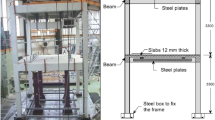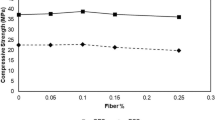Abstract
This paper presents the effect of using Carbon Fiber Reinforced Polymers (CFRP) as retrofitting material on seismic behavior of Plain Cement Concrete (PCC) and Glass Fiber Reinforced Concrete (GFRC). The experimental work was carried out in two steps. In first step, cylindrical specimens of size 150 mm × 300 mm were cast by using both PCC and GFRC. In second step, the specimens were wrapped by CFRP in three different patterns. All the specimens were tested under monotonic compressive loading. The test results were later used in the non-linear static cyclic analysis of reinforced concrete frame modeled in a finite element based analytical tool. Seismic vulnerability assessment was then carried out using a modified capacity spectrum method to develop analytical curves for the frames. The results showed significant improvement in seismic performance of frames strengthened by CFRP. Collapse hazard level for unconfined GFRC structure was increased by 20.73% as compared to unconfined PCC structure. There was 21 to 28% improvement observed in collapse hazard level in confined PCC structures as compared to their unconfined counterparts. However, confinement of GFRC structures resulted in only 8% increase in collapse hazard level as compared to unconfined GFRC structures.
Similar content being viewed by others
References
Abdullah, M. M. and Jallo E. K. (2012). “Mechanical properties of glass fiber reinforced concrete.” Al-Rafadain Engineering Journal, Vol. 20, No. 5, pp. 128–135.
ACI (1992). State-of-the-Art Report on Bond under Cyclic Loads. Reported by ACI Committee 408, ACI 408.2R-92, ACI, Michigan.
ACI 318-08 (2008). “Building Code Requirements for Structural Concrete (ACI 318-08) and Commentary (ACI 318R-08). The American Concrete Institute.
Adaganti, S. Y. (2014). “Recovery and re-use of Glass fibers for composite reinforcements.” Journal of Scientific and Industrial Research, Vol. 73, No. 10, pp. 671–673.
Assa, B., Nishiyama, M., and Watanabe, F. (2001). “New approach for modeling confined concrete. I: Circular Columns.” Journal of Structural Engineering, Vol. 127, No. 7, pp. 743–750, DOI: 10.1061/(ASCE)0733-9445(2001)127:7(743).
ATC 40 (1996). “Seismic evaluation and retrofit of concrete buildings.” Applied Technology Council, Report No. SSC 96-01.
Bakis, C. E., Bank, L. C., Brown, V. L., Cosenza, E., Davalos, J. F., Lesko, J. J., Machida, A., Rizkalla, S. H., and Triantafillou, T. C. (2002). “Fiber-reinforced Polymer Composites for Construction—State-of-the-Art Review.” Journal of Composites for Construction, Vol. 6, No. 2, pp. 73–87, DOI: 10.1061/(ASCE)1090-0268(2002) 6:2(73).
Bournas, D. and Triantafillou, T. (2011). “Bar Buckling in RC Columns Confined with Composite Materials.” J. Compos. Constr., DOI: 10.1061/(ASCE)CC.1943-5614.0000180, pp. 393–403.
Bournas, D., Triantafillou, T., Zygouris, K., and Stavropoulos, F. (2009). “Textile-reinforced mortar versus FRP jacketing in seismic retrofitting of RC columns with continuous or lap-spliced deformed Bars.” J. Compos. Constr., DOI: 10.1061/(ASCE)CC.1943-5614. 0000028, 360–371.
Calvi, G. M., Pinho, R., Magenes, G., Bommer, J. J., Restrepo-Vé lez, L. F., and Crowley, H. (2006). “The development of seismic vulnerability assessment methodologies over the past 30 years.” ISET Journal of Earthquake Technology, Vol. 43, No. 3, pp. 75–104.
Carlin, B. P. (1998). Investigation of the strength and ductility of reinforced concrete beams strengthened with CFRP laminates, Master Thesis submitted to the Virginia Polytechnic Institute and State University.
CEB-FIP Model Code for Concrete Structures (1990). Gmite’Euro-International du Be’ton el Federation International de al Pre-Contrainte, Lausanne, Switzerland.
Chaitanya kumar, J. D., Abhilash, G. V. S., Khasim Khan P., Manikanta Sai, G., and Taraka Ram V. (2016). “Experimental studies on glass fiber concrete.” American Journal of Engineering Research (AJER), Vol. 5, No. 5, pp. 100–104.
Chandramouli, K., Sekhar, T. S., Sravana, P., Pannirselvam, N., and Rao, P. S. (2010). “Strength properties of glass fiber concrete.” ARPN journal of Engineering and Applied Sciences, Vol. 5, No. 4, pp. 1–6.
Ching, Au (2001). “Behavior of FRP confined concrete.” Master Thesis submitted to the Massachusetts Institute of Technology.
Choi, Y. and Yuan, R. (2005). “Experimental relationship between splitting tensile strength and compressive strength of GFRC and PFRC.” Cement And Concrete Research, Vol. 35, No. 8, pp. 1587–1591, DOI: 10.1016/j.cemconres.2004.09.010.
Di Ludovico, M., Prota, A., Manfredi, G., and Cosenza, E. (2008) “Seismic strengthening of an under-designed RC structure with FRP.” Earthquake Engineering & Structural Dynamics, Vol. 37, No. 1, pp. 141–62.
Eurocode-8 (2004). “Design of structures for earthquake resistance-Part 1: General rules, seismic actions and rules for buildings.” CEN.
FEMA 440 (2005). “Improvement of nonlinear static seismic analysis procedures.” Issued by Federal Emergency Management Agency, Department of Homeland security, USA, June 2005.
Fukuyama, H., Suzuki, H., and Nakamtwa, H. (1999). “Seismic retrofit of reinforced concrete columns by fiber sheet wrapping without removal of finishing mortar and side wall concrete.” Fiber Reinforced Polymer Reinforcement for Reinforced Concrete Structures. Dolan, C.W., Rizkalla, S.H. and Nanni, A. (eds), ACI Report SP-188. Detroit, Michigan, pp. 205–216.
Girard J. (2008). “Introduction to GFRC (Glass Fiber Reinforced Concrete).” The concrete countertop Institute. Retrieved from http://www.concretecountertopinstitute.com/modules/smartsection/item.php?itemid=57.
Gornale, A., Quadri, S. I., Quadri, S. M., Ali, S. M. A., and Hussaini, S. S. (2012). “Strength aspects of glass fibre reinforced concrete.” International Journal of Scientific & Engineering Research, Vol. 3, No. 7, pp. 1–5.
Griffiths, R. and Ball, A. (2000). “An assessment of the properties and degradation behaviour of glass-fibre-reinforced polyester polymer concrete.” Composites Science and Technology, Vol. 60, No. 14, pp. 2747–2753, DOI: 10.1016/S0266-3538(00)00147-0.
Harajli, M. H. (2006b). “Effect of confinement using steel, FRC, or FRP on the bond stress-slip response of steel bars under cyclic loading.” Mater. Struct., Vol. 39, No. 00, pp. 621–634.
Harle, S. M. (2014). “Review on the performance of glass fiber reinforced concrete.” International Journal of Civil Engineering Research, Vol. 5, No. 3, pp. 281–284.
HAZUS 99 (1999). The Earthquake Loss Estimation Program of USA, launched by Federal Emergency Management Agency of USA.
Inel, M. and Ozmen, H. B. (2006). “Effects of plastic hinge properties in nonlinear analysis of reinforced concrete buildings.” Engineering Structures, Vol. 28, No. 11, pp. 1494–1502.
Jeong, S. H. and Elnashai, A. S. (2005). “Analytical assessment of an irregular RC frame for full-scale 3D pseudodynamic testing Part I: Analytical model verification.” Journal of Earthquake Engineering, Vol. 9, No. 1, 95–128.
Kobatake, Y., Kimura, K., and Katsumata, H. (1993). “A retrofitting method for reinforced concrete structures using carbon fiber.” Fiber-Reinforced-Plastic (FRP) Reinforcement for Concrete Structures: Properties and Applications, Narmi, A. (ed.), Elsevier Science Publishers, pp. 435–450.
Kyriakides, N. (2007). Vulnerability of RC buildings and risk assessment for Cyprus, Doctoral dissertation submitted to the Faculty of Engineering in the University of Sheffield, UK.
Lam, L. and Teng, G. J. (2004). “Ultimate condition of fiber reinforced polymer-confined concrete.” Journal of Composites for Construction, ASCE, Vol. 8, No. 6, pp. 539–548, DOI: 10.1061/(ASCE)1090-0268 (2004)8:6(539).
Lorenzis, L. D. and Tepfers, R. (2003). “Comparative study of models on confinement of concrete cylinders with fiber-reinforced polymer composites.” Journal of Composites for Construction, Vol. 7, No. 3, pp. 219–237, DOI: 10.1061/(ASCE)1090-0268(2003)7:3(219).
Masukawa, J., Akiyama, H., and Saito, H. (1997). “Retrofit of existing reinforced concrete piers by using carbon fiber sheet and ammid fiber sheet.” Proceedings of the 3ro Conference on Non-Metallic (FRP) Reinforcement for Concrete Structures (Vol. 1). Japan Concrete Institute, pp. 411–418.
Michael, A. P., Hamilton, H. R., and Ansley, M. H. (2005). “Concrete confinement using carbon fiber reinforced polymer grid.” Proc. of the Seventh International Symposium of the Fiber-Reinforced Polymer Reinforcement for Reinforced Concrete Structures (FRPRCS-7), Kansas City, Missouri.
Murthy, Y. I., Sharda, A., and Jain, G. (2012). “Performance of glass fiber reinforced concrete.” International Journal of Engineering and Innovative Technology, Vol. 1, No. 6, pp. 246–248.
Pantelides, C. P., Clyde, C., and Reaveley, L. D. (2000a). “Rehabilitation of R/C buildings joints with FRP composites.” Proceedings of the 12tn World Conference on Earthquake Engineering, New Zealand, Paper no. 2306.
Pantelides, C. P., Gergely, J., Reaveley, L. D., and Vohayy, V. A. (2000b). “Seismic strengthening of reinforced concrete bridge pier with FRP composites.” Proceedings of the 12th World Conference on Earthquake Engineering, New Zealand, paper no. 127.
Richart, F. E., Brandtzaeg, A., and Brown, R. L. (1928). “A study of the failure of concrete under combined compressive stresses.” Engineering Experimental Station Bulletin No. 185, Univ. of Illinois, Urbana, IL, USA.
Saadatmanesh, H., Ehsani, M. R., and Jin, L. (1996). “Seismic strengthening of circular bridge pier models with fiber composites.” ACI Structural Journal, Vol. 93, No. 6, pp. 639–647.
Saiidi, S., Sanders, D. H., Gordaninejad, F., Martinovic, F. M., and McElhaney, B. A. (2000). “Seismic retrofit of non-prismatic RC bridge columns with fibrous composites.” Proceedings of the 12th World Conference on Earthquake Engineering, New Zealand, Paper no. 123.
Seible, F., Priestley, M. J. N., Hegemier, G. A., and Innamorato, D. (1997). “of RCcolumns with continuous carbon fiber jackets.” ASCE-Journal of Compositesfor Construction, Vol. 1, No. 2, pp. 52–62.
Shakor, P. N. and Pimplikar, S. S. (2011). “Glass fibre reinforced concrete use in construction.” International Journal of Technology And Engineering System, Vol. 2, No. 2, pp. 632–634.
Sheikh, S. A., Iacobucci, R., and Bayrak, O. (2000). “Seismic upgrade of concrete columns with fibre reinforced polymers.” Advanced Composite Materials in Bridges and Structures. Humar, J., and Razaqpur, A.G. (eds), Montreal: The Canadian Societyfor Civil Engineering, pp. 267–274. Srinivasa Rao and Seshadri
Sekhar, T. (2005). “Strength and durability properties of glass fibre reinforced concrete.” Proceedings of the International Conference on Recent Advances in Concrete and Construction Technology, December 7-9, SRMIST, Chennai, India. pp. 43–50.
Tetta, Z., Koutas, L., and Bournas, D. (2015). “Textile-reinforced mortar (TRM) versus Fiber-reinforced Polymers (FRP) in shear strengthening of concrete beams.” Composites Part B: Engineering, Vol. 77, pp. 338–348, DOI: 10.1016/j.compositesb.2015.03.055.
Uniform Building Code. (1997). Issued by International Council of Building Officials (ICBO).
Xiao, Y. and Wu, H. (2000). “Compressive behavior of concrete confined by carbon fiber composite jackets.” ASCE Jour. of Materials in Civil Eng., Vol. 12, No. 2, pp. 139–146, DOI: 10.1061/(ASCE)0899-1561(2000)12:2(139).
Author information
Authors and Affiliations
Corresponding author
Rights and permissions
About this article
Cite this article
Qureshi, L.A., Ahmad, J. & Salahuddin, H. Seismic vulnerability assessment of strengthened Glass Fiber Reinforced Concrete (GFRC). KSCE J Civ Eng 21, 2235–2244 (2017). https://doi.org/10.1007/s12205-016-0819-4
Received:
Revised:
Accepted:
Published:
Issue Date:
DOI: https://doi.org/10.1007/s12205-016-0819-4




